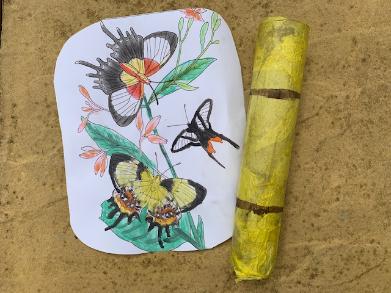Secret Art of Survival Accessible Family Resource Pack

EXPLORING THE SECRET ART OF SURVIVAL AT HOME
These activities are inspired by a hidden history of the Second World War, when thousands of allied servicemen became prisoners of the Japanese, known as FEPOW. Japanese military philosophy held that anyone surrendering was
beneath contempt. As a result, their treatment of captives was harsh.
The Secret Art of Survival focuses on the British FEPOW who used art to record their lives and to keep up morale.
The project is a collaboration between the Liverpool School of Tropical Medicine (LSTM) who have been treating and working with FEPOW survivors since 1945, and the Victoria Gallery and Museum (VG&M) who have curated the Secret Art of Survival exhibition.
To discover more real life stories, images and audio check out – www.captivememories.org.uk and www.vgm.liverpool.ac.uk.
To help you get the most from the activities we have added an age range as a guide and a list of the materials you will need.
This resource can be used for non-commercial uses only. You must credit the image and copyright holders of the image and Liverpool School of Tropical Medicine and Victoria Gallery & Museum, University of Liverpool.
EXPLORE THE JUNGLE (Age 4 and up)
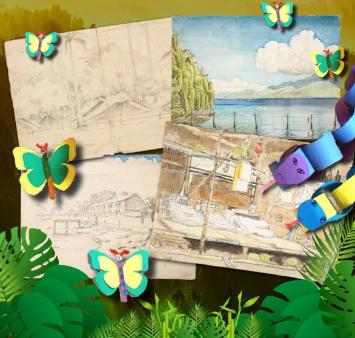
Some of the men were imprisoned in camps in the jungle. This was very different to their homes in Great Britain.
Can you…Draw your own jungle picture and the animals and insects that you might find there? (Prisoners saw monkeys, snakes and elephants as well as large spiders, butterflies and beetles!)
Materials needed
• Paper
• Colouring pens
• Pencils
• Crayons
JUNGLE CRAFTS (Age 4 and up)
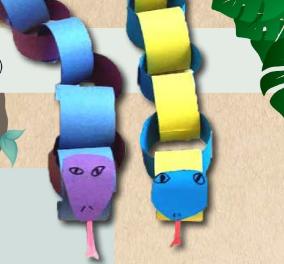
The jungle was filled with many types of snakes.
Can you…Make your own paper chain snake?
Materials needed
• Paper/card
• Scissors
• Glue/Sellotape
• Googly eyes/coloured pens
• Choose your coloured paper or card.
• Cut it into strips (approximately 20cm long by 3cm wide).
• Roll a strip for the head and glue/Sellotape it into a ring.
• Thread the next strip through the first ring, roll and glue/Sellotape the ends together to secure. This is the start of your snake’s body. Continue making links until your snake is the length you want.
• Cut out a head for your snake and attach to the first ring.
• Cut out a forked tongue. Stick the tongue to the underside of the snake head.
• Attach the head to the snake body.
• Add two googly eyes or use pens to make your own eyes.
BEAUTIFUL BUTTERFLIES
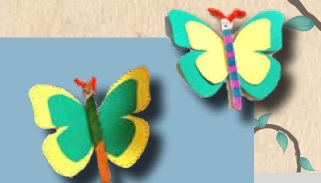
The prisoners saw many beautiful butterflies.
Can you…Make your own butterfly?
Materials needed
• Paper
• Scissors
• Lolly pop stick/card
• Pipe cleaners/or card
• Draw the outline of a butterfly and a smaller one to go in the middle (you can find templates online).
• Stick the two together with the smaller one in the centre.
• Use a wooden lolly pop stick or draw your own body. Colour and stick in the middle.
• Make antenna out of pipe cleaners or card.
HIDDEN ARTWORKS (Age 4 and up)
FEPOW were forbidden to keep any writing or drawing materials and punishment was harsh and swift. But their need was so great that the writing and art they created had to be hidden from the prison guards.
John Clement secretly filled 20 notebooks full of drawings. Look at some of the pictures the prisoners drew to inspire your drawings.
Can you…Draw your own pictures and make your own hiding place?
Watch the Video Tutorial
Materials needed
• Paper
• Colouring pens,pencils, paints
• Coloured paper/tissue paper to decorate
• Toilet paper tube, kitchen roll tube, card rolled up to make a tube
• Sellotape/glue
• What could you draw to make yourself smile and the other people around you?
• Your artwork would have to be hidden. The prisoners often used the bamboo tubes as well as putting them in bottle and tins and burying them under their huts.
• Find a tube or make one and decorate it, drawing lines around it representing the bamboo rings.
• Roll up your artwork and slide it inside the tube.
WILDLIFE ARTIST (Age 4 and up)
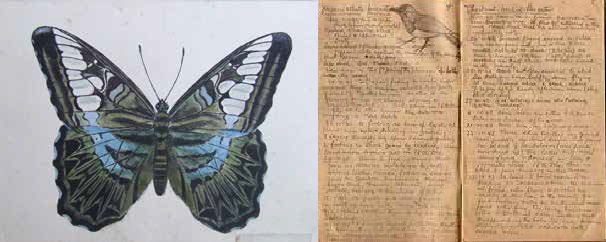
Men like Jack Spittle loved birds and insects and filled his notebooks with the birds he saw. One Senior Officer kept his men busy and distracted by asking some of them to capture butterflies, and those who could, to paint them. He returned home with both the watercolours and the actual butterflies. His daughter still has his stunning butterfly collection.
Materials needed
• Paper
• Pencil,
colouring pens/
pencils, paint
Can you…
• Go out into your garden, look through the window or explore your local area? What insects and birds can you spot?
• Draw what you find and label them. What do they look like?
What colour are they? What noise do they make?
COMFORT CREATURES (Age 4 and up)
Look at the picture below. Some of the men created small items, keepsakes, which gave them comfort whilst imprisoned. In the exhibition there were homemade cards celebrating birthdays and special occasions and these were treasured by the men who received them.

Materials needed
• Colouring pencils and pens, paints
• Paper
• Materials from the house, e.g. Cardboard
Can you…
• Spot any creatures in this picture? Clue – look at the top of the bed spaces!
• Draw or make your own keepsake. What would you choose to comfort you?
CAMP ENTERTAINMENT (Age 4 and up)
To keep spirits up and keep busy, some of the men worked together to put on shows for their fellow prisoners.
Materials needed
• Pens, pencils,
• Paper
• A place to perform
Can you…
• Look at the artwork created by the prisoners showing the theatre productions and as a family create your own talent
show?
• Decide on each of your talents. Practice and perform.
• Create posters for your event, chose a date and time.
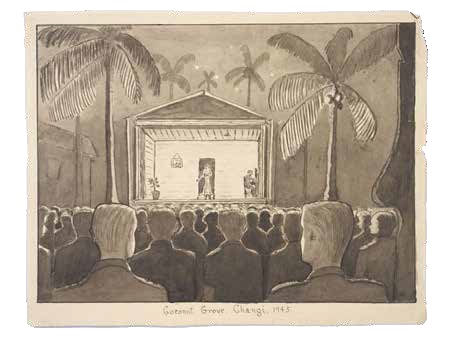
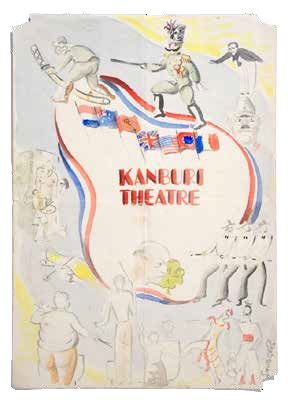
INVENTOR CHALLENGE (Age 7 and up)
Below is a drawing of a dentist chair made from bamboo.
The prisoners put all their different skills and experiences together to help each other survive. Their medical inventions included making medicines right through to building operating theatres and saving thousands of lives. They had to be inventive when trying to solve certain problems and use what they could find around them.
Can you… Become an inventor?
• Imagine you only have the following materials:
1. Scrap wood, wire, broken razor blades, bamboo in various lengths.
2. String, rope, material from clothing, jungle vines.
3. Latex taken from rubber trees that could be used as a type of glue.
4. Kapok (a bit like cotton). The buds provided a fine silky material for stuffing pillows and pads for the injured/sick.
5. Prisoners did steal some work tools from the Japanese workshops.
• How could you use these to solve the following problems:
1. Moving water from stream to camp
2. Cooking food
3. Keeping the sun off you
4. Keeping mosquitoes off you
5. Moving bags of rice
6. Sleeping comfortably
• Draw your inventor blueprint labelling each part.
• You can make a model of your invention at home using materials you have in the house e.g. straws for bamboo.
Bamboo dental chair made at Chungkai Hospital camp Thailand, sketched by Lieutenant F. Ransome-Smith,
© courtesy C. Ransome and Museum of Military Medicine
CODE BREAKING CHALLENGE 1 (Aged 10 upwards)
PITMAN SHORTHAND CODE
Communication to and from FEPOW was difficult. The men moved around a lot and sometimes they did not have a chance to send one postcard.
When they did it could take many months for their postcard to arrive home and many months for them to get a reply. Their mail was also heavily censored so many FEPOW took to sending coded messages home.
Fergus Anckorn used Pitman’s shorthand (used until the 1980s by journalists and secretaries to take notes) as a code to send messages home to his parents. As they were journalists they could decode the message.
Materials needed
• English words and Pitman’s symbols sheet
• Paper, pen/pencil
Can you…
• Use the Pitman’s shorthand symbols (right) and try to disguise your words within the postcard template?
• Can you hide your own messages just like Fergus did? Use the postcard template and cross out the sentences which do not apply to you as the soldiers would have done and hide your messages in the crossings out.
• Ask members of your family to see if they can find your code within the postcard and use the decoder sheet to work out what you are trying to tell them.

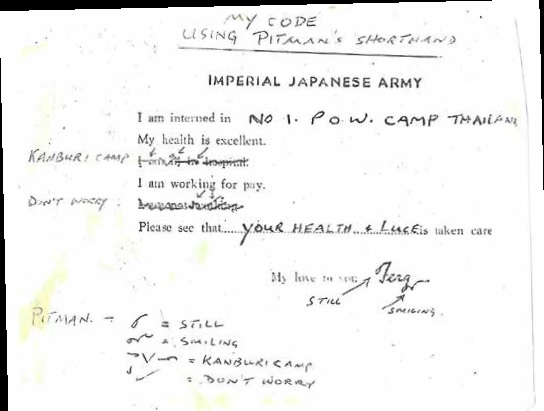
IMPERIAL JAPANESE ARMY
I am interned in .........................................................................................
My health is excellent................................................................................
I am in hospital..........................................................................................
I am working for pay.................................................................................
I am not working......................................................................................
Please see that......................................................................is taken care
My love to you .................................
CODE BREAKING CHALLENGE 2 (Aged 10 upwards)
CAPTAIN DUNCAN’S CODE
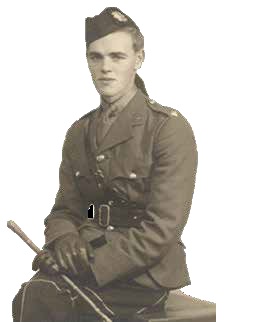
Materials needed
• Pen, pencil
• Paper
Can you…
• Write your own coded message imagining you are writing to a family member in the prison?
• Use people, places and things familiar to your family (see example to Captain Duncan) Ask your family to decode your message. Can they do it? The aim is to give the prisoners you are writing to hope.
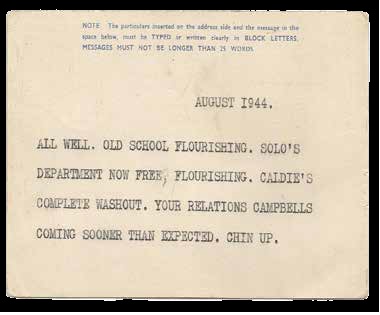
Interpreted as:
All well. Old school flourishing = school being used as a guide to the code.
Solo’s department now free, flourishing = Miss Sanderson (unmarried, she was rather unkindly known as Solo to pupils!) was the French teacher, meaning France is free!
Caldie’s complete washout = Dr Caldwell (Caldie) taught Latin, meaning Italy has lost.
Your relations Campbells coming sooner than expected. Chin up = “The Campbell’s are Coming” was Duncan’s regimental marching tune, meaning, it won’t be long now, the army is coming to rescue you soon.
CODE BREAKING CHALLENGE 3 (Aged 10 upwards)
Materials needed
• Pen, pencil
• Paper
Can you…
• Create your own code? Create your own alphabet or words with your own unique code (this can be made up symbols or numbers or characters/stories your family might know) and set your family the challenge of solving your message.
Remember you will need:
• An alphabet or words/phrases to make up your code.
• A way to decipher your code.
• Remember! The code needs to be hidden in your message so the guards do not spot anything which could get you into trouble and you would be punished.

This resource was written and produced by Lorna Kernahan and designed by William Evers-Swindell for the Secret Art of Survival: Creativity and ingenuity of British Far Eastern Prisoners of War, 1942 - 1945.
lornaruthkernahan@gmail.com
